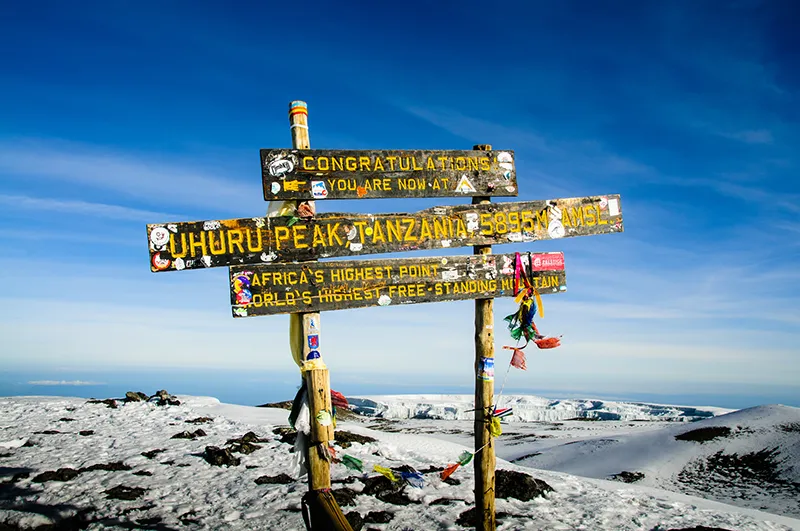Kilimanjaro is a mountain range of volcanic origin on the East African plateau, which is located in the most attractive area for tourists in Africa – Tanzania, near the border with Kenya.
Kilimanjaro is one of the tallest standing alone mountain ranges on the globe.
Kilimanjaro is most often photographed from the Kenyan side. This is usually where tourists’ attempts to climb the white roof of the black continent begin.
The highest mountain in Africa
For many decades, tourists from Western Europe have been having pleasant vacations in Kenya, visiting the Serengeti National Park and the Kilimanjaro mountain range, which are located in Tanzania.
There were no problems until 1977. It was enough to get into a jeep and cross the green border to enjoy the natural beauties of the neighboring country. But in this case all the profits went to Kenya, where tourists vacationed and paid for services, while Tanzania got nothing, although it offered most of the entertainment associated with safaris, lions and elephants around the Ngorongoro volcano, Lake Manyara and, of course, Kilimanjaro. Tanzania closed its border on February 4, 1977 and began making efforts to develop its own tourism sector – whoever wanted to enjoy the beauty of Tanzanian nature had to stay in Tanzania. Unfortunately, the ambitious plan collapsed – the profits were far less than expected, and six years later the border reopened. The roads in this area are such that only off-road vehicles can drive on them, but the driver-guides have serious training and take care of tourists with great responsibility.
Until now hotels for tourists with very good service are located on the territory of Kenya and the main flow of those wishing to visit the Kilimanjaro region and national parks of Tanzania first gets to Kenya. As tourists who have visited these places say, Kenyans are more businesslike, but Tanzanians are more friendly. The colonial legacy is reflected in the fact that almost the entire population of the area where the tourist routes pass through speaks English. This is due to the fact that even in the poorest villages, children are enrolled in schools where they learn English.
The majestic Mount Kilimanjaro is known as a lonely massif rising above the East African plateau near the northern border of Tanzania. Its peaks are covered with snow caps that can be seen from hundreds of kilometers away.
Many tourists visit Tanzania to climb Kilimanjaro. In this case, you do not need any special mountaineering skills. The slopes are not steep, some routes allow you to reach the eternal ice without equipment. Climbing Kilimanjaro is unforgettable – thanks to the variety of landscapes and rich flora. Here one passes through several climatic zones. Savannah and fertile lands extend to a height of 1800 m, tropical forests – up to 4000 m, alpine meadows – up to 4400 m, and at high altitudes there are eternal snows and glaciers.
Several national parks have been created here. One of the most beautiful – Ngorongoro – is a crater up to 19 km in diameter, the bottom of which is a habitat for numerous species of animals, provided with natural sources of food and water.
Many tribes endow Kilimanjaro with divine meaning. For the Maasai, for example, it is “the mountain that sparkles”. This area is widely known thanks to Ernest Hemingway’s story “The Snows of Kilimanjaro”, in which the author writes: “Almost at the very top of the western peak lies the dried frozen corpse of a leopard. What the leopard needed at such a height, no one can explain.” Hemingway wrote the real truth. In 1926, two English monks came across a stiffened leopard at what was later called Leopard Point.
There are various hypotheses about the origin of the name Kilimanjaro. Missionary Johann Ludwig Krapf, who discovered Kilimanjaro to Europeans in 1848, translated the name as “caravan of mountains”.

General information
- Tribes inhabiting the foothills of the mountains: Maasai, Chaga.
- The largest settlement: Moshi town.
- Peaks: Uhuru (Kibo) (5895 m), Mawenzi (5149 m), Shira (3962 m).
- Diameter of Kibo crater: 2 km.
- Area under the glacier: 4 km2.
Economy
- Agriculture: bananas, coffee and cotton are grown on the lower mountain slopes.
- Tourism.
Climate and weather
- The climate is equatorial mountainous.
- Kilimanjaro provides an opportunity to observe the change of climate from tropical to arctic as one ascends to the summit.
- The heaviest rains are from March to May and a period of less heavy rains from November to December.
- The driest period is from August to October.
Attractions
- The tribes that lived around Kilimanjaro in ancient times believed that it was the abode of evil spirits and did not risk climbing to the summits.
- The highest point of Kibo Volcano, the highest mountain in the Kilimanjaro massif, is known as Uhuru Peak.
Fun Facts
- The closure of the border between Kenya and Tanzania in 1977 put over 1000 tourists in a desperate situation – 200 jeeps and 29 airplanes were confiscated.
- The famous animated film “The Lion King” is set in the Kilimanjaro region.
- The screen adaptation of Ernest Hemingway’s story “The Snows of Kilimanjaro” in 1952 (starring Gregory Peck and Ava Gardner) was a huge success.
- Hans Meyer was the first man to climb the highest point of Kilimanjaro in 1889.




